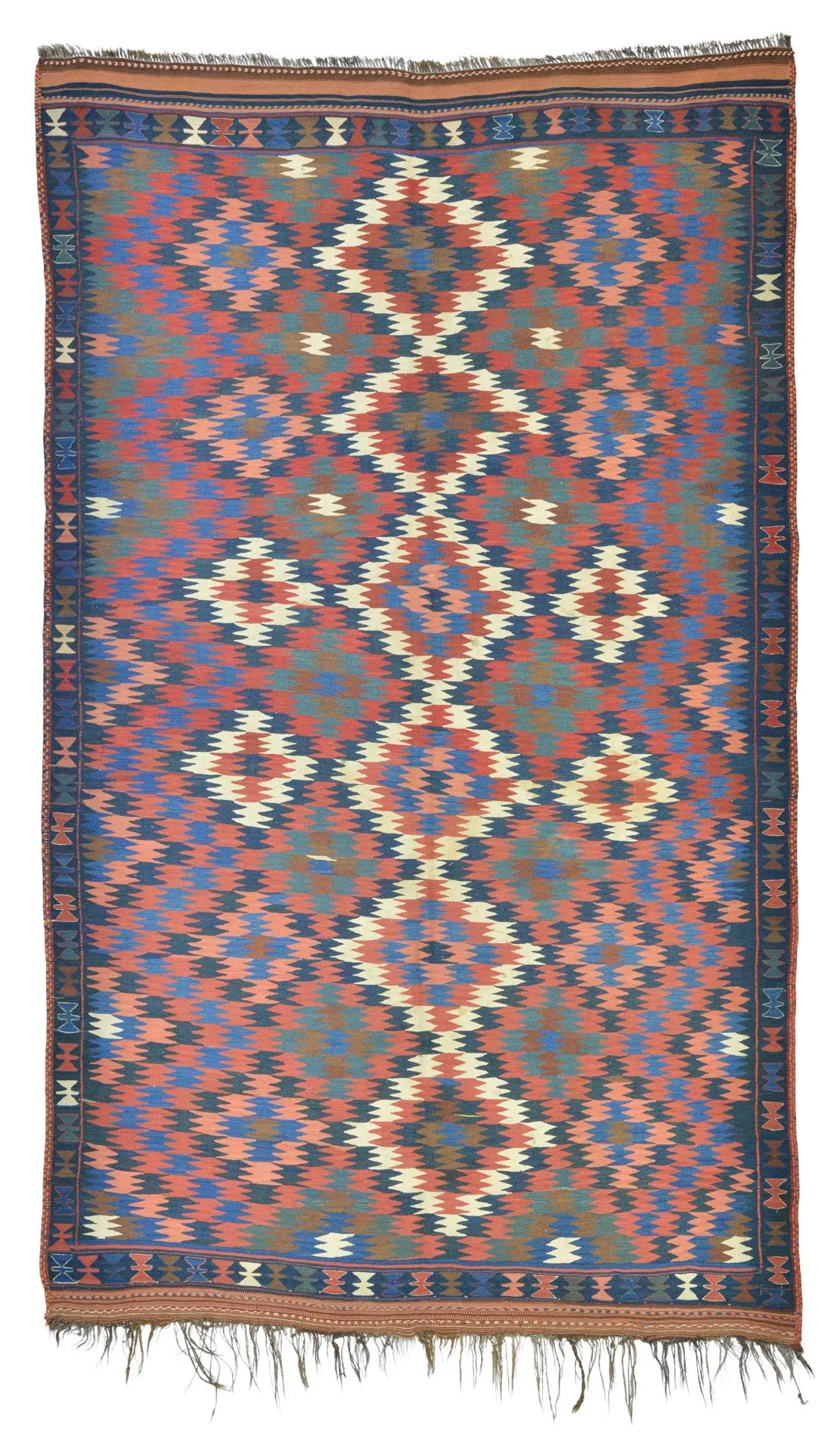Kilims and flat-weaves are some of the most interesting tribal rugs. The women make such pieces for the floors of their tents. They need such covers for the floor of their tents that they erect in the pastoral camps.
Such items must be light and versatile. They use them as rugs, wall coverings, and even blankets. They are not as heavy and thick as pile rugs and are easier to transport.
When it comes to creating kilims, tribal women make their wild imaginations fly and do miracles. They depict motives that they have inherited from their ancestors and freely develop new ones. They create the most remarkable pieces in a technique that has thousands of years of history. Some of the kilims are astonishing art objects. The tribal women have woven them for and out of their hearts and not for the market. Thus are the often irregular shapes, designs, and colors.
We are proud to have a beautiful collection of such pieces in our gallery.
140361
No. 140361 - 279x142cm. Circa 1950s
A Qashghai Moj (Jajim) - Wool
One of the most striking scenes in the old bazaar of Shiraz used to be the Qashqai women in their elegant dresses of vibrant colour, coming to shop for provisions when their tribes camped around the city. Their taste for colour, their free spirit and their graceful presence offered a living glimpse into the source of the exuberance that radiated from their weavings.
The piece presented here is what the Qashqai call Moj, known as Jajim among collectors. These flatweaves were made on portable looms using ancient techniques, and as the width of the looms was limited, they were usually woven in two or more sections that were later joined to form a wider piece. Created primarily to decorate the interiors of their nomadic tents, they were yet another expression of the Qashqai love for colour. The fine quality of the wool, combined with the weight and tightly woven structure, made these textiles suitable not only for decoration but also for practical use, including as floor coverings and protective storage cloths.
Today, such sights and lifestyles have largely faded, making these weavings precious reminders of a world that no longer exists, vibrant echoes of a culture once defined by movement, imagination and an intimate bond with nature.
510457
No. 510457 - 284x167cm. Circa late 19th century
A Varamin Shahsavan - Wool
With its rich tones and striking texture, this kilim carries the story of nomadic groups who were once moved to the plains of Varamin near Tehran, placed there under the watchful eyes of the king to keep them close, to prevent unrest, to keep them under control. Confined to a far smaller territory than the vast slopes of the Zagros Mountains or the open plains of Moghan, they settled and remained. Generations later, their descendants live as city dwellers in Varamin and Tehran, no longer practising the weaving traditions of their ancestors, and pieces such as this stand today as witnesses to those challenging times.
The kilim presented here was woven in the late 19th century by Shahsavan groups who had originally migrated from the plains of Moghan to the Varamin area. Its bold stripes and subtle variations preserve both the memory of freedom and the resilience of a people learning to root themselves in unfamiliar soil, while such weavings intrigue the viewer to explore their fascinating history and to cherish the beauty and charm of pieces whose cultural significance continues to deepen their appeal.
For two years, starting circa 104BC, the Chinese army of Emperor Wu (156 – 87 BC) of the Han dynasty fought a battle with the Saka-ruled Greco-Bactrian kingdom that is known in history as "The Battle of Heavenly Horses". The Hans attacked westward after a dispute that followed an expedition to acquire the legendary Akhal-Teke horses from Sakas. The creatures were celebrated and mythicized in China for their beauty, speed, and sweating blood (Han Xu Ma: Sweat blood).
The expedition and the war initiated the eastern leg of the Silk Road.
Akhal-Teke horses are of Turkoman breed and remain one of the most valued horses.
Horse riding and horses are part of the Turkoman culture and are always a historical source of pride. Therefore it is not a surprise that Torkuman girls have woven some of the finest and most beautiful horse coverings like the one in this post.
The weaver of this fabulous collectable piece, a Teke Torkuman horse cover, Circa 1880s, has used an extraordinary level of skill with impeccable attention to detail to create this majestic dress for one of the finest horses in the land.
59249 . A silk shahasavan sumak. 100x141cm





















